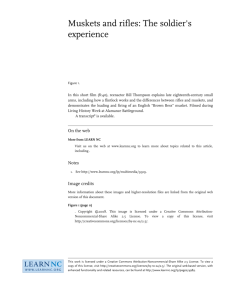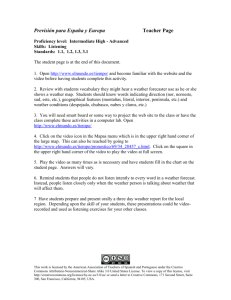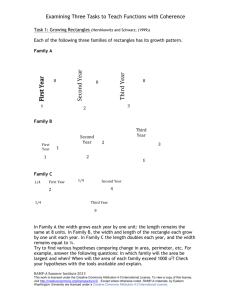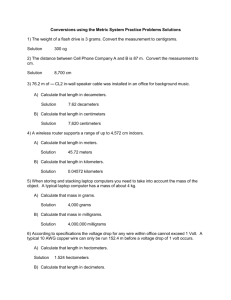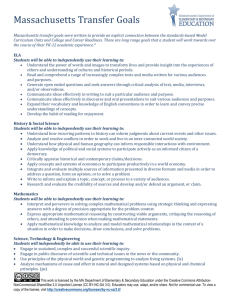checklist for effective reports
advertisement
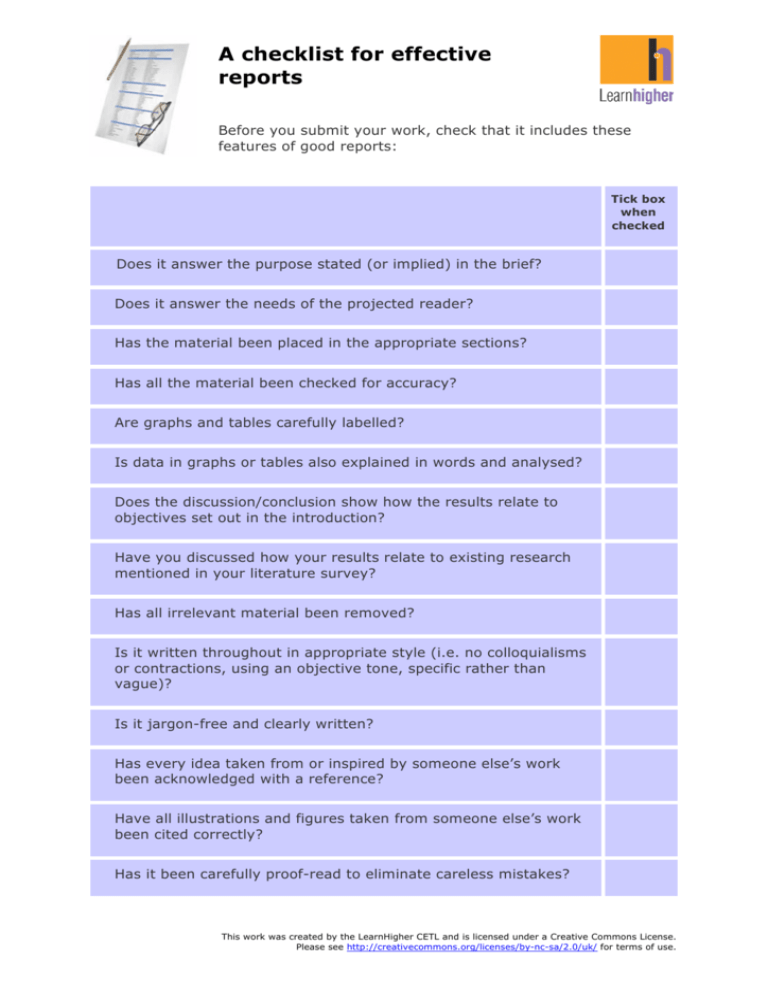
A checklist for effective
reports
Before you submit your work, check that it includes these
features of good reports:
Tick box
when
checked
Does it answer the purpose stated (or implied) in the brief?
Does it answer the needs of the projected reader?
Has the material been placed in the appropriate sections?
Has all the material been checked for accuracy?
Are graphs and tables carefully labelled?
Is data in graphs or tables also explained in words and analysed?
Does the discussion/conclusion show how the results relate to
objectives set out in the introduction?
Have you discussed how your results relate to existing research
mentioned in your literature survey?
Has all irrelevant material been removed?
Is it written throughout in appropriate style (i.e. no colloquialisms
or contractions, using an objective tone, specific rather than
vague)?
Is it jargon-free and clearly written?
Has every idea taken from or inspired by someone else’s work
been acknowledged with a reference?
Have all illustrations and figures taken from someone else’s work
been cited correctly?
Has it been carefully proof-read to eliminate careless mistakes?
This work was created by the LearnHigher CETL and is licensed under a Creative Commons License.
Please see http://creativecommons.org/licenses/by-nc-sa/2.0/uk/ for terms of use.
!""#$%&'#()%*+,(-*&+#.(
;4#$(<#6"'(#(+)),QA#,(&"-)&$>(
="&"(#&"(')<"()*($4"(<)'$(9)<<)1(9)<-5#01$'(#A)%$(&"-)&$':((
!"#$%&"'()*(+)),(
&"-)&$'(
! R#,5B('$&%9$%&",(
! 81#--&)-&0#$"(/&0$01+('$B5"(
! 819)&&"9$()&(01#,"C%#$"(&"*"&"1901+(
! S)"'1T$(#1'/"&($4"(A&0"*(
(
."-)&$(/&0$01+(2(
! 3))(<%94Q$))(50$$5"Q0&&"5"@#1$(<#$"&0#5(
(
! UM-&"''0)1(1)$(95"#&(
340'(+%0,"(0'($4"(*0&'$()*($4&""(5))601+(#$(&"-)&$(/&0$01+7(8$(0195%,"':(
! S)"'1T$(&"5#$"(&"'%5$'($)(-%&-)'"(
! O11"9"''#&B(%'"()*(V#&+)1(
• ;4#$(#(&"-)&$(0'(
=)/(9#1(B)%(<#6"('%&"(B)%&(&"-)&$(,)"'(/4#$(0$T'(<"#1$($)(,)H(#1,(,)"'(0$(
/"55>(
• ;4#$(<#6"'(#(+)),(&"-)&$(
• =)/(&"-)&$'(#&"(&"#,(
3)-($0-W(
;4#$(0'(#(&"-)&$>(
?(&"-)&$(0'(#(-0"9"()*(01*)&<#$0@"(/&0$01+($4#$(,"'9&0A"'(#('"$()*(#9$0)1'(#1,(
#1#5B'"'(#1B(&"'%5$'(01(&"'-)1'"($)(#('-"90*09(A&0"*7(?(C%096(,"*010$0)1(<0+4$(A":(
D340'(0'(/4#$(8(,0,(#1,($40'(0'(/4#$(0$(<"#1'7E(F)%(<#B(A"(+0@"1(#1(#''0+1<"1$(
/4094(0'(1)$(9#55",(#(&"-)&$(A%$('4#&"'(<#1B()*($4"('#<"(*"#$%&"'G(0*(')H(#'-"9$'(
)*($40'(+%0,"(/055(A"(4"5-*%57(
34"(<)'$(0<-)&$#1$($401+($)(,)(0'(3#/+(%4#(53&#"(L)&($4"($0$5"()*(B)%&(
#''0+1<"1$H()&(B)%&(&"'"#&94(C%"'$0)1N($/3#"*66,7(34"1(&"#,(0$(#+#01("@"1(
<)&"(9#&"*%55BX(8*(B)%T&"('$055(1)$(9)<-5"$"5B(95"#&(#A)%$(/4#$($)(,)H('-"#6($)(
B)%&($%$)&()&(#(J$%,B(?,@0'"&(Y(,)1T$(+%"''7(
•
Z#6"('%&"(B)%(61)/(/4094('"9$0)1'(B)%&(&"-)&$('4)%5,(4#@"(#1,(/4#$(
'4)%5,(+)(01("#947(."-)&$'(*)&(,0**"&"1$(,0'90-501"'(#1,(A&0"*'(/055(&"C%0&"(
,0**"&"1$('"9$0)1':(*)&(01'$#19"H(#(A%'01"''(&"-)&$(<#B(1"",(#('"-#&#$"(
."9)<<"1,#$0)1'('"9$0)1(A%$(1)(Z"$4),'('"9$0)17([4"96(B)%&(A&0"*(
9#&"*%55B($)(<#6"('%&"(B)%(4#@"($4"(9)&&"9$('"9$0)1'7(J""(0#123%(73&%&89(
:;()%3*$%*3&89(,2*3(3#123%($)(5"#&1(<)&"(#A)%$(/4#$(+)"'(/4"&"7((
•
."<"<A"&($4#$(&"-)&$'(#&"(<"#1$($)(A"(01*)&<#$0@":($)($"55($4"(&"#,"&(
/4#$(/#'(,)1"H(/4#$(/#'(,0'9)@"&",(#'(#(9)1'"C%"19"(#1,(4)/($40'(
&"5#$"'($)($4"(&"#')1'($4"(&"-)&$(/#'(%1,"&$#6"17(8195%,"()15B(&"5"@#1$(
<#$"&0#5(01(B)%&(A#96+&)%1,(#1,(,0'9%''0)17(
•
?(&"-)&$(0'(#1(#9$()*(9)<<%109#$0)1(A"$/""1(B)%(#1,(B)%&(&"#,"&7(J)(-#B(
'-"90#5(#$$"1$0)1($)(/4)(B)%&(-&)V"9$",(&"#,"&(0'H(#1,(/4#$($4"B(/#1$(
*&)<($4"(&"-)&$7(J)<"$0<"'(B)%(/055(A"(#'6",($)(/&0$"(*)&(#1(0<#+01#&B(
(
="&"(#&"(')<"(6"B(,0**"&"19"'(A"$/""1(&"-)&$'(#1,("''#B'7(
!../,.(
0#123%.(
?&+%<"1$#$0@"(#1,(0,"#IA#'",(
J"<0I'$&%9$%&",(
K)$(/&0$$"1(/0$4(#('-"90*09(&"#,"&(01(
<01,(L"M9"-$($4"(<#&6"&N(
;&0$$"1(01('01+5"(1#&&#$0@"('$B5"(
$4&)%+4)%$((
O'%#55B(,)(1)$(0195%,"('%AI4"#,01+'(
O'%#55B(,)(1)$(0195%,"(A%55"$(-)01$'(
O'%#55B(1)($#A5"'()&(+&#-4'((
P**"&(9)195%'0)1'(#A)%$(C%"'$0)1((
81*)&<#$0@"(#1,(*#9$IA#'",(
!)&<#55B('$&%9$%&",(
O'%#55B(/&0$$"1(/0$4(#('-"90*09(
-%&-)'"(#1,(&"#,"&(01(<01,(
;&0$$"1(01('$B5"(#--&)-&0#$"($)("#94(
'"9$0)1(
?5/#B'(0195%,"('"9$0)1(4"#,01+'(
P*$"1(%'"(A%55"$(-)01$'(
P*$"1(0195%,"'($#A5"'()&(+&#-4'(
P**"&(&"9)<<"1,#$0)1'(*)&(#9$0)1((
•
•
•
•
•
&"#,"&(L"7+7(#(A%'01"''(950"1$N7(81($40'(9#'"(0$T'(@0$#5($)($4016(#A)%$(/4B($4"B(
/#1$($4"(&"-)&$($)(A"(-&),%9",(L"7+7($)(,"90,"()1($4"(@0#A050$B()*(#(-&)V"9$N(
#1,($)(<#6"('%&"(B)%(&"'-)1,($)($4#$7(8*(0$T'(B)%&($%$)&H($4"B(/055(/#1$($)(
61)/($4#$(B)%(9#1(9)<<%109#$"($4"(-&)9"''"'(#1,(&"'%5$'()*(B)%&(
&"'"#&94(95"#&5B(#1,(#99%&#$"5BH(#1,(9#1(,0'9%''(B)%&(*01,01+'(01($4"(
9)1$"M$()*($4"()@"&#55(-%&-)'"7(((
[4"9650'$(*)&(+)),(&"-)&$'(
!
S)"'(0$(#1'/"&($4"(-%&-)'"('$#$",(L)&(0<-50",N(01($4"(A&0"*>((
!
S)"'(0$(#1'/"&($4"(1"",'()*($4"(-&)V"9$",(&"#,"&>(
!
=#'($4"(<#$"&0#5(A""1(-5#9",(01($4"(#--&)-&0#$"('"9$0)1'>(
;&0$"('0<-5B(#1,(#--&)-&0#$"5B7(J""(0#123%(73&%&89(<=(>3&%&89(,2*3(
3#123%(*)&(<)&"()1($40'=(
!
=#'(#55($4"(<#$"&0#5(A""1(94"96",(*)&(#99%&#9B>(
!
?&"(+&#-4'(#1,($#A5"'(9#&"*%55B(5#A"55",>(
F)%&(<"$4),(#1,(*01,01+'('4)%5,(A"(,"'9&0A",(#99%&#$"5B(#1,(01(1)1I
#<A0+%)%'($"&<'7(?(-"&*"9$5B(,"'9&0A",(<"$4),('"9$0)1(/)%5,(<#6"(0$(
-)''0A5"(*)&(')<")1"("5'"($)(&"-509#$"(B)%&(&"'"#&94(-&)9"''(#1,(#940"@"(
$4"('#<"(&"'%5$'7(
!
8'(,#$#(01(+&#-4'()&($#A5"'(#5')("M-5#01",(01(/)&,'(#1,(#1#5B'",>(
!
S)"'($4"(,0'9%''0)1Q9)195%'0)1('4)/(4)/($4"(&"'%5$'(&"5#$"($)()AV"9$0@"'(
'"$()%$(01($4"(01$&),%9$0)1>(
!
=#'(#55(0&&"5"@#1$(<#$"&0#5(A""1(&"<)@",>(
!
8'(0$(/&0$$"1($4&)%+4)%$(01(#--&)-&0#$"('$B5"(L07"7(1)(9)55)C%0#50'<'()&(
9)1$&#9$0)1'H(%'01+(#1()AV"9$0@"($)1"H('-"90*09(&#$4"&($4#1(@#+%"N>(
!
8'(0$(V#&+)1I*&""(#1,(95"#&5B(/&0$$"1>(
!
=#'("@"&B(0,"#($#6"1(*&)<()&(01'-0&",(AB(')<")1"("5'"T'(/)&6(A""1(
#961)/5",+",(/0$4(#(&"*"&"19">(
!
=#@"(#55(055%'$&#$0)1'(#1,(*0+%&"'($#6"1(*&)<(')<")1"("5'"T'(/)&6(A""1(
90$",(9)&&"9$5B>((
!
=#'(0$(A""1(9#&"*%55B(-&))*I&"#,($)("50<01#$"(9#&"5"''(<0'$#6"'>(
J-"1,($0<"()1(B)%&(,0'9%''0)1('"9$0)17(340'(0'($4"(A0$($4#$(-%55'($4"(/4)5"(
-0"9"($)+"$4"&(AB('4)/01+(4)/(B)%&(*01,01+'(&"5#$"($)($4"(-%&-)'"()*($4"(
&"-)&$H(#1,($)(#1B(-&"@0)%'(&"'"#&947((
U@"&B(0,"#(#1,(-0"9"()*(01*)&<#$0)1(B)%(%'"($4#$(9)<"'(*&)<(')<")1"(
"5'"T'(/)&6(?*.%(A"(#961)/5",+",(/0$4(#(&"*"&"19"7([4"96(B)%&(A&0"*H()&(
,"-#&$<"1$(4#1,A))6(*)&($4"(*)&<()*(&"*"&"1901+(&"C%0&",(L%'%#55B(#(
'4)&$(&"*"&"19"(01($4"(A),B()*($4"($"M$H(#1,(#(*%55(&"*"&"19"(01($4"(
."*"&"19"(\0'$(#$($4"("1,N7((
34"(/)&,(9)%1$(/055($"55(B)%(/4#$($4"('9)-"()*($4"(&"-)&$(0'7(?(]^^^(/)&,(
&"-)&$(/055(A"("M-"9$",($)(0195%,"(#(5)$(<)&"(A#96+&)%1,(#1,(,0'9%''0)1(
$4#1(#(2^^^(/)&,(&"-)&$H(/4094(/055(A"(5))601+(*)&(<)&"(9)190'"1"''(01(
$4"(/#B(B)%(9)1@"B(B)%&(01*)&<#$0)17((
=)/(#&"(&"-)&$'(&"#,>(
."'"#&94()1(4)/(<#1#+"&'(&"#,(&"-)&$'(,0'9)@"&",($4#$($4"B(/"&"(<)'$(506"5B(
$)(&"#,(L01()&,"&N:($4"(#A'$&#9$()&('%<<#&BG($4"1($4"(01$&),%9$0)1G($4"1($4"(
9)195%'0)1'G($4"1($4"(*01,01+'G($4"1($4"(#--"1,09"'7(((
340'(0'(1)$($)('%++"'$($4#$(B)%('4)%5,('-"1,(5"''($0<"()1(/&0$01+(%-(B)%&(
*01,01+'7(R%$(0$(,)"'('4)/($4#$($4"('"9$0)1'(B)%(<#B($4016()*(#'(5"''(0<-)&$#1$(
!)&(<)&"(#,@09"H('""W7(
0#123%(73&%&89(:=()%3*$%*3&89(,2*3(3#123%7(
0#123%(73&%&89(<=(>3&%&89(,2*3(3#123%=(
777=6#/384&94#3=/$=*@A6#/38&89/3#/.A3#123%73&%&89A&8%32+*$%&28=4%?(
!)&(<)&"(()1($40'(#1,()$4"&(#'-"9$'()*(#9#,"<09('$%,BH('""(
)%&(/"A'0$"(#$(777=3+9=/$=*@A.%*+,/+'&$#(
(
$4"0&(*0&'$(0<-&"''0)1'7(J)(0$T'(/)&$4(+"$$01+($4"<(&0+4$7((
_(S&(`0<(J4#4#A%,01H(S&(?1+"5#(3#B5)&H(S&(a%,B(3%&1"&(b(S&(
Z094"55"(."0,7((O10@"&'0$B(J$%,B(?,@09"($"#<(b(\"#&1=0+4"&(
[U3\(L."#,01+NH(c^^d7
(
(
L506"($4"(#A'$&#9$()&(01$&),%9$0)1N(#&"(#9$%#55B()*$"1($4"(-5#9"'(#(&"#,"&(+"$'(
(
12,)NC3"#6%"OPK,%$"&7,)3$<<6#*L)&3)"2,)Q32+-)/&'4+/R)5+#)*+$#)
#,-+#"8)9")&3)"2,)5&#3")G6'4)3+<,"&<,3)"2,)+':*I)3,%"&+')"+)C,)#,64)6'4)32+$:4)C,)
"2,):63")"+)C,)/#&"",'8)9")32+$:4),'6C:,)"2,)#,64,#)"+)<6@,)6')&'5+#<,4)
4,%&3&+')6C+$")/2,"2,#)"2,*)/6'")"+)#,64)"2,)#,-+#")&"3,:58)H,'("2)4,-,'43)+')
"2,),K",'")+5)"2,)/+#@)#,-+#",4)=)$3$6::*)6)-6#6(#6-2)+#)"/+)6'4)6:/6*3):,33)
"26')6)-6(,8)9")32+$:4)C#&,5:*),K-:6&';))
!""#$%&'#()%*+,(-*&+#.(
!"#$%"$#&'()*+$#)
#,-+#")
.,-+#")/#&"&'()0)
)
)
12&3)($&4,)&3)"2,)3,%+'4)+5)"2#,,)+')#,-+#")/#&"&'()6")$'&7,#3&"*8)9")&'%:$4,3)
647&%,)+';)
• 12,)<+3")%+<<+':*=5+$'4)3,%"&+'3)+5)6)#,-+#")
• 12,)5$'%"&+')+5),6%2)3,%"&+'>)6'4)2+/)"+)4,%&4,)/2,#,)*+$#)&'5+#<6"&+')
/&::)(+)
!"#$%"$#&'()*+$#)#,-+#")
?':&@,),336*3>)#,-+#"3)267,)5+#<6:)3"#$%"$#,38)A2,')/#&"&'()6'),336*>)*+$)
',,4)"+)-:6%,)*+$#)&'5+#<6"&+')%/(012#(1(.%3/45(135*0#4%8)A2,')/#&"&'()6)
#,-+#">)*+$)',,4)"+)-:6%,)*+$#)&'5+#<6"&+')&4(%6#(1773/73&1%#(.#$%&/48)
B+'3&4,#)"2,)#+:,),6%2)&",<)/&::)-:6*)&')%+<<$'&%6"&'()&'5+#<6"&+')+#)&4,63)"+)
"2,)#,64,#>)6'4)-:6%,)&")&')"2,)3,%"&+')/2,#,)&")/&::)C,3")-,#5+#<)"26")#+:,8)D+#)
&'3"6'%,;)
!
E+,3)&")-#+7&4,)C6%@(#+$'4)"+)*+$#)#,3,6#%2F)G9'"#+4$%"&+')+#)
H&",#6"$#,).,7&,/I)
!
E+,3)&")4,3%#&C,)"2,)"*-,3)+5)6%"&7&"*)*+$)$3,4)"+)%+::,%"),7&4,'%,F)
GJ,"2+43I)
!
E+,3)&")-#,3,'")56%"$6:)46"6F)G.,3$:"3I)
!
E+,3)&")-:6%,),7&4,'%,)&')"2,)%+'",K")+5)C6%@(#+$'4F)GE&3%$33&+'I))
!
E+,3)&")<6@,)#,%+<<,'46"&+'3)5+#)6%"&+'F)GB+'%:$3&+'I)
1+-)"&-L))
.,-+#"3)5+#)4&55,#,'")C#&,53)/&::)#,M$&#,)4&55,#,'")3,%"&+'3)"+)C,)&'%:$4,48)
B2,%@)*+$#)C#&,5)%6#,5$::*)5+#)"2,)3,%"&+'3)"+)&'%:$4,)&')*+$#)5&'6:)#,-+#"8))
•
"2,)-$#-+3,)+5)"2,)/+#@))
•
<,"2+43)$3,4)5+#)#,3,6#%2))
•
<6&')%+'%:$3&+'3)#,6%2,4))
•
6'*)#,%+<<,'46"&+'3))
)
12,)9'"#+4$%"&+'L)32+$:4),K-:6&')"2,)#6"&+'6:,)5+#)$'4,#"6@&'()"2,)
/+#@)#,-+#",4)+'>)6'4)"2,)/6*)*+$)4,%&4,4)"+)4+)&"8)9'%:$4,)/26")*+$)267,)
C,,')63@,4)G+#)%2+3,'I)"+)4+)6'4)"2,)#,63+'3)5+#)4+&'()&"8))
• !"6",)/26")"2,)#,-+#")&3)6C+$"8)A26")&3)"2,)M$,3"&+')*+$)6#,)"#*&'()"+)
6'3/,#F)95)&")&3)6)C#&,5)5+#)6)3-,%&5&%)#,64,#)G,8(8)6)5,63&C&:&"*)#,-+#")+')6)
%+'3"#$%"&+')-#+S,%")5+#)6)%:&,'"I>)36*)/2+)"2,*)6#,8)
• E,3%#&C,)*+$#)3"6#"&'()-+&'")6'4)"2,)C6%@(#+$'4)"+)"2,)3$CS,%";),8(8>)/26")
#,3,6#%2)263)6:#,64*)C,,')4+',)G&5)*+$)267,)"+)&'%:$4,)6)H&",#6"$#,).,7&,/>)
"2&3)/&::)+':*)C,)6)C#&,5)3$#7,*IT)/26")6#,)"2,)#,:,76'")"2,<,3)6'4)&33$,3T)
/2*)6#,)*+$)C,&'()63@,4)"+)&'7,3"&(6",)&")'+/F))
• PK-:6&')2+/)*+$)6#,)(+&'()"+)(+)6C+$")#,3-+'4&'()"+)"2,)C#&,58)95)*+$)6#,)
(+&'()"+)",3")6)2*-+"2,3&3)&')*+$#)#,3,6#%2>)&'%:$4,)"2&3)6")"2,),'4)+5)*+$#)
&'"#+4$%"&+'8)9'%:$4,)6)C#&,5)+$":&',)+5)*+$#)<,"2+4)+5),'M$&#*8)!"6",)"2,)
:&<&"3)+5)*+$#)#,3,6#%2)6'4)#,63+'3)5+#)"2,<>),8(8)
U.,3,6#%2)/&::)5+%$3)+')'6"&7,)P'(:&32)3-,6@,#3)+':*>)63)6)-#+-,#)%+'3&4,#6"&+')+5)
"2,)&33$,3)6#&3&'()5#+<)3-,6@&'()P'(:&32)63)6)3,%+'4):6'($6(,)&3)C,*+'4)"2,)3%+-,)+5)
"2&3)-#+S,%"V8)
)
12,)H&",#6"$#,).,7&,/L)3$#7,*3)-$C:&%6"&+'3)GC++@3>)S+$#'6:3)6'4)
3+<,"&<,3)%+'5,#,'%,)-6-,#3I)+')/+#@)"26")263)6:#,64*)C,,')4+',)+')"2,)
"+-&%)+5)*+$#)#,-+#"8)9")32+$:4)+':*)&'%:$4,)3"$4&,3)"26")267,)4&#,%")#,:,76'%,)
"+)*+$#)#,3,6#%28))
9'"#+4$%,)*+$#)#,7&,/)C*),K-:6&'&'()2+/)*+$)/,'")6C+$")5&'4&'()*+$#)
<6",#&6:3>)6'4)6'*)%:,6#)"#,'43)&')#,3,6#%2)"26")267,),<,#(,48))W#+$-)*+$#)
",K"3)&')"2,<,38)A#&",)6C+$"),6%2)"2,<,)63)6)3,-6#6",)3,%"&+'>)(&7&'()6)%#&"&%6:)
3$<<6#*)+5),6%2)-&,%,)+5)/+#@>)6'4)32+/&'()&"3)#,:,76'%,)"+)*+$#)#,3,6#%28)
B+'%:$4,)/&"2)2+/)"2,)#,7&,/)263)&'5+#<,4)*+$#)#,3,6#%2)G"2&'(3)*+$R::)C,)
C$&:4&'()+'>)(6-3)*+$R::)C,)5&::&'(),"%I8)
12,)B+'%:$3&+'3L)32+$:4)C,)6)32+#")3,%"&+')/&"2)'+)',/)6#($<,'"3)+#)
,7&4,'%,8)!$<)$-)"2,)<6&')-+&'"3)+5)*+$#)#,3,6#%28)X+/)4+)"2,*)6'3/,#)"2,)
+#&(&'6:)C#&,5)5+#)"2,)/+#@)#,-+#",4)+'F)12&3)3,%"&+')<6*)6:3+)&'%:$4,;)
)
)
12,)J,"2+43L)32+$:4)C,)/#&"",')&')3$%2)6)/6*)"26")6)#,64,#)%+$:4)
#,-:&%6",)"2,)#,3,6#%2)*+$)267,)4+',8)!"6",)%:,6#:*)2+/)*+$)%6##&,4)+$")*+$#)
&'7,3"&(6"&+'8)PK-:6&')/2*)*+$)%2+3,)"2&3)-6#"&%$:6#)<,"2+4)GM$,3"&+''6&#,3>)
5+%$3)(#+$->),K-,#&<,'"6:)-#+%,4$#,),"%I8)9'%:$4,)",%2'&M$,3)6'4)6'*)
,M$&-<,'")*+$)$3,48)95)"2,#,)/,#,)-6#"&%&-6'"3)&')*+$#)#,3,6#%2>)/2+)/,#,)
"2,*F)X+/)<6'*F)X+/)/,#,)"2,*)3,:,%",4F))
95)*+$)6#,)$'%,#"6&')6C+$")2+/)+#)/2,')"+)#,5,#,'%,>)3,,)+$#)!""#$%&'#()%*+,(
-*&+#.(/4(9#"#3#4$&45>)676&:6C:,)&')-6-,#)+#)+':&',)6")
///8#4(86%8$@O3"$4*3@&::3O3"$4*\#,3+$#%,3O#,5,#,'%&'(82"<8)
A#&",)"2&3)3,%"&+')$/4$&.#8,)C$")%6/3/*568,)Y)W+)"2#+$(2)/26")*+$)4&4)3",-)
C*)3",->)&'%:$4&'(),7,#*"2&'()"26")&3)#,:,76'"8)Z+$)@'+/)/26")*+$)4&4>)C$")
%+$:4)6)#,64,#)5+::+/)*+$#)4,3%#&-"&+'F)))
)
12,).,3$:"3OE6"6OD&'4&'(3L)"2&3)3,%"&+')263)+':*)+',)S+C>)/2&%2)&3)
"+)-#,3,'")"2,)5&'4&'(3)+5)*+$#)#,3,6#%2)63)3&<-:*)63)-+33&C:,8)?3,)"2,)5+#<6")
"26")/&::)6%2&,7,)"2&3)<+3"),55,%"&7,:*;),8(8)",K">)(#6-23>)"6C:,3)+#)4&6(#6<38)
E+'R")#,-,6")"2,)36<,)&'5+#<6"&+')&')"/+)7&3$6:)5+#<6"3)G,8(8)6)(#6-2)6'4)6)
"6C:,I8))
H6C,:)*+$#)(#6-23)6'4)"6C:,3)%:,6#:*8)W&7,),6%2)5&($#,)6)"&":,)6'4)4,3%#&C,)&')
/+#43)/26")"2,)5&($#,)4,<+'3"#6",38)!67,)*+$#)&'",#-#,"6"&+')+5)"2,)#,3$:"3)
5+#)"2,)E&3%$33&+')3,%"&+'8)D+#)2,:-)/&"2)3"6"&3"&%6:)6'6:*3&3>)"#*)"2,)J6"23)
!$--+#")B,'"#,)///8#4(86%8$@O<6"233$--+#"O)+#)"2,)!"6"&3"&%6:)N47&3+#*)
!,#7&%,)///8#4(86%8$@O3"6"3=647&3+#*8))
)
12,)E&3%$33&+'L)&3)-#+C6C:*)"2,):+'(,3")3,%"&+'8)9")C#&'(3),7,#*"2&'()
"+(,"2,#>)32+/&'()2+/)*+$#)5&'4&'(3)#,3-+'4)"+)"2,)C#&,5)*+$),K-:6&',4)&')
*+$#)&'"#+4$%"&+')6'4)"2,)-#,7&+$3)#,3,6#%2)*+$)3$#7,*,4)&')*+$#):&",#6"$#,)
#,7&,/8)12&3)&3)"2,)-:6%,)"+)<,'"&+')&5)"2,#,)/,#,)6'*)-#+C:,<3)G,8(8)*+$#)
#,3$:"3)/,#,)4&55,#,'")5#+<),K-,%"6"&+'3>)*+$)%+$:4'R")5&'4)&<-+#"6'")46"6>)+#)
*+$)264)"+)%26'(,)*+$#)<,"2+4)+#)-6#"&%&-6'"3I)6'4)2+/)"2,*)/,#,)+#)%+$:4)
267,)C,,')3+:7,48))
!
.,%+<<,'46"&+'3)5+#)6%"&+')
!
!$((,3"&+'3)5+#)5$#"2,#)#,3,6#%2)
12,).,5,#,'%,)H&3"O[&C:&+(#6-2*L):&3")5$::)4,"6&:3)5+#)6'*)/+#@3)
*+$)267,)#,5,##,4)"+)&')"2,)#,-+#"8)D+#)"2,)%+##,%")3"*:,)+5)#,5,#,'%&'()"+)$3,>)
%2,%@)6'*)&'3"#$%"&+'3)*+$)<6*)267,)C,,')(&7,'8))
)
12,)N--,'4&%,3L)&'%:$4,)6'*)644&"&+'6:)&'5+#<6"&+')"26")<6*)2,:-)"2,)
#,64,#)C$")&3)'+"),33,'"&6:)"+)"2,)#,-+#"R3)<6&')5&'4&'(3T)5+#)&'3"6'%,>)&'",#7&,/)
M$,3"&+'3>)#6/)46"6>)+#)6)(:+336#*)+5)",#<3)$3,48)H6C,:)6::)6--,'4&%,3)6'4)#,5,#)
"+)"2,<)/2,#,)6--#+-#&6",)&')"2,)<6&')",K")G,8(8)Q!,,)N--,'4&K)N)5+#)6')
,K6<-:,)M$,3"&+''6&#,RI8)
)
D+#)<+#,)&'5+#<6"&+'>)3,,L8)
9#7/3%(:3&%&45(;<(=#1%*3#.(/"(5//+(3#7/3%.8)
9#7/3%(:3&%&45(><(?3&%&45(,/*3(3#7/3%<(
:::<8#1346&56#3<1$<*2@8#134&4513#1.@3#7/3%:3&%&45@&4%3/+*$%&/4<6%0(
(
D+#)<+#,))+')"2&3)6'4)+"2,#)63-,%"3)+5)6%64,<&%)3"$4*>)3,,)
+$#)/,C3&",)6"(:::<3+5<1$<*2@.%*+,1+'&$#(
(
])E#)^&<)!2626C$4&'>)E#)N'(,:6)16*:+#>)E#)_$4*)1$#',#)`)E#)
J&%2,::,).,&48))?'&7,#3&"*)!"$4*)N47&%,)",6<)`)H,6#'X&(2,#)
BP1H)G.,64&'(I>)0aab8
)
!"#$#%&'5953+=#95::('
!""#$%&'#()%*+,(-*&+#.(
!"#$#%&'5953+=#95::('=+5%2'."#$#%&'#%'2*91'
5'.5('$15$'()*"'#%4)"=5$#)%'2)*%32'
9"+3#@:+'5%3'5*$1)"#$5$#6+7'8$'3)+2'%)$'
=+5%;'
!"#$#%&'()*"'
"+,)"$'
-+,)"$'."#$#%&'/'
'
'
01#2'&*#3+'#2'$1+'$1#"3')4'$1"++')%'"+,)"$'."#$#%&'5$'*%#6+"2#$(7'8$'#%9:*3+2;'
• <))3'."#$#%&'2$(:+''
• !"#$#%&'5953+=#95::('
• >#%#21#%&'$)*91+2'
'
<))3'."#$#%&'2$(:+'
!1+%'()*'."#$+'5'"+,)"$'()*'5"+'9)==*%#95$#%&'()*"'?%).:+3&+'5@)*$'5'2+$'
)4'59$#)%2'$)'5'"+53+"7'01+'?+('1+"+'#2'$/00*1&$2%&/17'A'&))3',#+9+')4'536#9+'
#2'$)'B."#$+'$)'+C,"+22D'%)$'$)'#=,"+22E7'F+"+'5"+'2)=+'$#,2'4)"'591#+6#%&'$1#2;'
!
!"#$+'#%',5"5&"5,12'.1#91'156+')%+'=5#%',)#%$'$15$'()*'#%$")3*9+D'
+C,5%3')%D'5%3'2*==5"#2+7''
!
G2#%&'21)"$+"'2+%$+%9+2'56)#32')6+"H9)=,:+C#$(7'
!
A6)#3'*2#%&'9)::)I*#5:#2=2'5%3'#%4)"=5:#$('#%'5953+=#9'."#$#%&7'
!
!"#$+'.)"32')*$'#%'4*::D'4)"'#%2$5%9+'*2+'B3)'%)$E'#%2$+53')4'B3)%E$E7'
!
J)'*2+'5,,"),"#5$+'$+91%#95:'$+"=2D'@*$'$"('$)'56)#3'K5"&)%'L'9)%2#3+"'
.1)'#2':#?+:('$)'"+53'()*"'"+,)"$'5%3'.1+$1+"'$1+('.#::'*%3+"2$5%3'$1+'
$+"=2'()*'*2+7''
!
84'()*E"+'%)$'2*"+'1).'$)'*2+',*%9$*5$#)%D'2++')*"'536#9+'5$''
...7"3&7597*?M2$*3(2?#::2M2$*3(N"+2)*"9+2M2$*3(N&*#3+2M,*%9$*5$#)%71$='
•
G2#%&':)%&'.)"32'
•
!"#$#%&'9)=,:#95$+3'2+%$+%9+2'.#$1':)$2')4'2+=#H9):)%2'5%3'9):)%2'
O)=+'2*&&+2$#)%2'4)"'."#$#%&'5953+=#95::(;'
3#(/45#$%&'#'L'"+,)"$'.15$'$1+'+6#3+%9+'$+::2'()*'+6+%'#4'#$'#2%E$'.15$'()*'
1),+3'$)'4#%37'J)%E$',"+2+%$'*%2*,,)"$+3')"',+"2)%5:'),#%#)%2;'4)"'#%2$5%9+D'
BG%2*","#2#%&:(D',5"$#9#,5%$2'.1)'"+9(9:+3'$1+#"'"+4*2+'=)"+'"+&*:5":('.+"+'
5:2)'%#9+"',+),:+E7'05?+'5'@5:5%9+3'6#+.7'
3#(2$$*62%#(L'&#6+'9:+5"'%)%H2*@K+9$#6+'3+29"#,$#)%2'PB:#&1$'@:*+E'#2'@+$$+"'$15%'
B2?('@:*+EQ'5%3'3+4#%#$+'4#&*"+2'PB54$+"'$.+%$('4#6+'=#%*$+2ED'BRST')4'$1+'
,5"$#9#,5%$2EQ7'A6)#3'65&*+')"'5=@#&*)*2'$+"=2':#?+'B5':)%&',+"#)3')4'$#=+ED')"'
B=)2$')4'$1+',5"$#9#,5%$2E7''
3#(+&6#$%'L'3)%E$':+56+'#$'$)'()*"'"+53+"'$)'.)"?')*$'.15$'()*'5"+'25(#%&U'
V*$$#%&'$1+'+=,152#2')%'5'2$")%&'6+"@'95%'1+:,'$1+'"+53+"'$)'2++'$1+'#=,)"$5%$'
,)#%$2;'4)"'#%2$5%9+D'B5%'5%5:(2#2'.52',+"4)"=+3')%'$1+'"+2*:$2E'#2'%)$'52'3#"+9$'
52'B$1+'"+2*:$2'.+"+'5%5:(2+3E7''
3#($6&%&$27(L'+65:*5$+'()*"').%'.)"?'52'.+::'52'$15$')4')$1+"27'F56+'$1+'
9)%4#3+%9+'$)'25('#4'2)=+$1#%&'9)*:3'156+'@++%'3)%+'@+$$+"'#4'#$'153'@++%'3)%+'
3#44+"+%$:(7'
3#(2886/86&2%#'L'#3+%$#4('$1+',*",)2+')4'()*"'9)==*%#95$#)%'5%3'$1+'
5*3#+%9+'()*'5"+'9)==*%#95$#%&'$)7'<#6+'$1+='$1+'#%4)"=5$#)%'$1+('%++3'$)'
*%3+"2$5%3'()*"'.)"?7'''
8$'5:.5(2'*2+3'$)'@+'"+9)==+%3+3'#%'5953+=#9'."#$#%&'$15$'()*'*2+3'$1+'
,522#6+'6)#9+'L'#%')$1+"'.)"32D'B$1+'+C,+"#=+%$'.52'9)%3*9$+3E'"5$1+"'$15%'
B.+'9)%3*9$+3'$1+'+C,+"#=+%$E7'W5%(',+),:+'"+9)&%#2+'%).'$15$'$1#2'95%'=5?+'
."#$#%&',)=,)*2'5%3')6+":('9)=,:#95$+37'8$E2'.)"$1'9)%2#3+"#%&'.1+$1+"'
*2#%&'$1+'59$#6+'6)#9+'P#7+7'8'3#3D'.+'3#3Q'.#::'=5?+'$1+'59$#)%2'()*'5"+'
"+,)"$#%&'+52#+"'$)'*%3+"2$5%37'X1+9?'5%('#%2$"*9$#)%2'()*'156+'4)"'&*#3+:#%+2'
)%'$1#2'H'#4'#%'3)*@$D'*2+'$1+',522#6+'6)#9+7''
!"#$#%&'()*"'"+,)"$'
>#%#21#%&'$)*91+2'
-+,)"$2'5"+'."#$$+%'$)'3+29"#@+'.)"?'9)=,:+$+3'#%'"+2,)%2+'$)'5',5"$#9*:5"'
@"#+4D'+#$1+"')%+'$15$'152'@++%'&#6+%'$)'()*D')"')%+'()*'156+'2+$'*,'()*"2+:47'
O);''
84'()*E"+'&)#%&'$)'&)'$)'$1+'$")*@:+')4'."#$#%&'5%'+C9+::+%$'"+,)"$D'#$E2'5'215=+'
$)'2,)#:'#$'.#$1'95"+:+22'4#%#21#%&7'84'()*'&#6+'()*"2+:4'$#=+'$)'91+9?'3+$5#:2'()*'
95%'=5?+'()*"',"+2+%$5$#)%'52'&))3'52'()*"'9)%$+%$7'
! 96&%#(&1(%:#(82.%(%#1.#(P52'()*'5"+'"+,)"$#%&')%'.15$'152'15,,+%+3Q''
<#"#6#1$&1;(H(`)*"'9)*"2+'15%3@))?'21)*:3'+C,:5#%'$1+'2$(:+')4'"+4+"+%9#%&'
,"+4+""+3'@('()*"'3+,5"$=+%$7'X1+9?'$15$'()*'156+'5::'$1+'%+9+225"('3+$5#:2'#%'
$1+'"#&1$',:59+27'84'()*E6+':)2$'$1+'3+$5#:2')4'5'2)*"9+D'3)%E$'#%9:*3+'#$'L'
*%59?%).:+3&+3'2)*"9+2'9)*:3'@+'"+53'52',:5&#5"#2=7'
! 2792,.(4#26(%:#(46&#"(&1(0&1+(9:&7#(,/*(26#(96&%&1;(
A%'#=,)"$5%$'3#44+"+%9+'@+$.++%'+225(2'5%3'"+,)"$2'$)'@+5"'#%'=#%3;''
•
+225(2'5"+'."#$$+%'#%'5'2#%&:+'%5""5$#6+'6)#9+'4")='@+&#%%#%&'$)'+%3'
•
"+,)"$2'5"+'."#$$+%'#%'2+9$#)%2'.1#91'=5('*2+'3#44+"+%$'2$(:+2')4'."#$#%&D'
3+,+%3#%&')%'$1+',*",)2+')4'$1+'2+9$#)%'
O)D'4)"'#%2$5%9+D'()*"'W+$1)32'5%3'-+2*:$2'2+9$#)%2'.#::'@+'3+29"#,$#6+D'()*"'
8%$")3*9$#)%'.#::'@+'+C,:5%5$)"(D'5%3'()*"'Y#$+"5$*"+'-+6#+.'5%3'J#29*22#)%'
2+9$#)%2'.#::'@+'5%5:($#95:7''
I6//"(6#2+&1;(L'V"#%$'()*"'.)"?')44'$)',"))4'"+53'L'()*'5"+'=)"+':#?+:('$)'
2,)$'+"")"27'8$'95%'1+:,'$)'"+53'5:)*37'G2+'2,+::'5%3'&"5==5"'91+9?+"2'.#2+:('L'
=5?+'2*"+'915%&+2'.)%E$'544+9$'.15$'()*'.5%$+3'$)'25(7''
J&%7#(82;#K($/1%#1%.K(7&.%(/"(&77*.%62%&/1.(H(a)$'5::'"+,)"$2'.#::'%++3'5::()4(
%1+2+'2+9$#)%27'84'()*"2'3)+2D'$1+((.#::',")@5@:('@+'$1+':52$'2+9$#)%2'$)'."#$+D'
)%9+'()*'5"+'9+"$5#%'$15$'$1+',5&+')"3+"'.#::'%)$'915%&+7'
0),'$#,b'
O++'<#8/6%(96&%&1;(=>()%6*$%*6&1;(,/*6(6#8/6%(4)"'=)"+')%'2+9$#)%27(
A'.+::',"+2+%$+3'"+,)"$':))?2',")4+22#)%5:'5%3'&#6+2'$1+'#=,"+22#)%'$15$'#$2'
5*$1)"'95"+3'5@)*$'&+$$#%&'$1#%&2'"#&1$'L'()*'95%':)2+'=5"?2'@('%)$'3)#%&'$1#2'
,"),+":(U'X1+9?'.1+$1+"'()*"'3+,5"$=+%$'152'536#9+')%'$1+'+C59$'4)"=5$7'
W*91')4'$1+'#%4)"=5$#)%'()*'.#::'%++3'.#::'@+'599+22#@:+')%:#%+D')%'
c:59?@)5"3')"'()*"'J+,$E2'.+@2#$+7'84'()*'95%E$'4#%3'#%4)"=5$#)%'5@)*$'
3+53:#%+2D'"+4+"+%9#%&'+$9D'52?'2)=+)%+7'J)%E$'&*+22'L'&*+22#%&'.")%&'9)*:3'
9)2$'()*'=5"?27'
F+"+'#2'5'2*&&+2$+3')"3+"'4)"'."#$#%&'$1+'=5#%'2+9$#)%2;'
Z7'?#%:/+.(5%3(@2%2A<#.*7%.;'A2'5'")*&1'&*#3+D'$1+'=)"+'459$*5:'$1+'2+9$#)%D'
$1+'+5":#+"'()*'21)*:3'."#$+'#$7'O)'2+9$#)%2'3+29"#@#%&(B.15$'()*'3#3'5%3'.15$'
()*'4)*%3E'5"+':#?+:('$)'@+'."#$$+%'4#"2$7''
[7'C1%6/+*$%&/1(5%3(D&%#62%*6#()*6'#,;'O+9$#)%2'$15$'+C,:5#%')"'+C,5%3')%'
$1+',*",)2+')4'$1+'"+2+5"91'21)*:3'@+'%+C$;'.15$'I*+2$#)%2'5"+'()*'2++?#%&'$)'
5%2.+"D'1).'3#3'$1+('5"#2+D'.1('5"+'$1+('.)"$1'#%6+2$#&5$#%&\'01+2+'.#::'1+:,'
()*'$)'2++'1).'$)'#%$+","+$'5%3'5%5:(2+'()*"'4#%3#%&27'
/7'@&.$*..&/1;']%9+'()*E6+'+2$5@:#21+3'$1+'I*+2$#)%2'()*"'"+2+5"91'#2'2++?#%&'
$)'5%2.+"D'()*'.#::'@+'5@:+'$)'2++'1).'()*"'"+2*:$2'9)%$"#@*$+'$)'$1+'5%2.+"2D'
5%3'.15$'?#%3')4'5%2.+"2'$1+(',)#%$'$)7'!"#$+'$1#2'+5":('+%)*&1'$15$'()*'2$#::'
156+'$#=+'$)'4#::'5%('&5,2'()*'4#%37'
^7'E/1$7*.&/1.(5%3(<#$/00#1+2%&/1.;'01+2+'21)*:3'4)::).':)&#95::('4")='
()*"'J#29*22#)%7'01+('21)*:3'2$5$+'()*"'9)%9:*2#)%2'5%3'"+9)==+%35$#)%2'
9:+5":('5%3'2#=,:(7'
_7'F4.%62$%A!G#$*%&'#()*0026,;']%9+'$1+'=5#%'@)3('#2'4#%#21+3'()*'95%'
."#$+'5'2*99#%9$'5%3'599*"5$+'2*==5"(')4'$1+'=5#%'4+5$*"+27'
>)"'=)"+'#%4)"=5$#)%D'2++b7'
<#8/6%(96&%&1;(L>(M#2%*6#.(/"(;//+(6#8/6%.7'
<#8/6%(96&%&1;(=>()%6*$%*6&1;(,/*6(6#8/6%>(
999>7#261:&;:#6>2$>*NA7#261&1;26#2.A6#8/6%96&%&1;A&1%6/+*$%&/1>:%0(
>)"'=)"+'')%'$1#2'5%3')$1+"'52,+9$2')4'5953+=#9'2$*3(D'2++'
)*"'.+@2#$+'5$(999>6+;>2$>*NA.%*+,2+'&$#(
(
d'J"'e#='O1515@*3#%D'J"'A%&+:5'05(:)"D'J"'f*3('0*"%+"'g'J"'
W#91+::+'-+#37''G%#6+"2#$('O$*3('A36#9+'$+5='g'Y+5"%F#&1+"'
Xh0Y'P-+53#%&QD'[SSR7
'
'
Identify the Audience and Purpose Exercise
For each of the following report briefs, identify:
•
•
•
Who the audience is
Why the report is needed
What the audience want to find out
Report Briefs:
1. Write a report for the Students Union of your university on students'
attitudes to binge drinking.
2. Report on the medical effects of binge drinking on university
students in the UK for a major alcopop manufacturer.
3. Conduct the experiment into the elasticity of chewing gum, and
hand in your lab report to your lecturer by 20th November.
4. After carrying out the experiment into the elasticity of chewing
gum, write up your findings in a report for a children's magazine.
5. Report for the charity "Greenpeace" on the use of Facebook
amongst 18-25 year olds as a means of social action and protest.
6. Investigate the use of Facebook as a means of social action and
protest by 18-25 year olds. This report has been commissioned by
the Metropolitan police.
This work was created by the LearnHigher CETL and is licensed under a Creative Commons License.
Please see http://creativecommons.org/licenses/by-nc-sa/2.0/uk/ for terms of use.
Organise your Report Exercise
The order in which the sections of these reports should go has been mixed
up - rearrange them into the most logical order.
For a quick exercise, simply re-number – a better way, if you have more time, is to write
the contents list out from scratch. Note that some information may go under a subheading within a particular section – you will need to work out where they belong.
Example A) Students' Preferences for Food Retailers on Campus
New order?
Appendices: Surveys and interview transcripts
Expansion of eating venues on campus in the last 5 years
Data Collection: Qualitative surveys and semi-structured interviews
Summary
Results: Semi-structured interviews
Discussion: Preferences for each venue
Aims and Objectives
Recommendations: Students want healthier food retailers
Results: Pilot survey
Overview of existing food retailers: union, library cafe, food hall
Bibliography
Example B) Suitability of Open Source Software for Start-Up Technology
Companies
New order?
Case Study 2: Out of the Box Design
Definition of Open Source Software
Bibliography
Case Study 1: Blue Sky Ltd
Executive Summary
Discussion: Themes from case studies
Recommendations
List of abbreviations
Survey of currently available Open Source Software
Conclusion: Advantages and Disadvantages of Open Source Software
Case Study 3: Marketing Web
Methodology: Case studies of small technology companies
This work was created by the LearnHigher CETL and is licensed under a Creative Commons License.
Please see http://creativecommons.org/licenses/by-nc-sa/2.0/uk/ for terms of use.
Example C) Lactic Acid Production in the Muscles of Swimmers During Different
Types of Training
New order?
Figure 3. Combination training
Conclusion
Abstract
Experiment 1: Aerobic exercise
Literature Review
Experiment 3: Combination training
Results
Aims and Hypotheses
Figure 1. Aerobic exercise
Introduction: Production of lactic acid when exercising
Figure 2. Anaerobic exercise
Discussion
Methods
Bibliography
Experiment 2: Anaerobic exercise
This work was created by the LearnHigher CETL and is licensed under a Creative Commons License.
Please see http://creativecommons.org/licenses/by-nc-sa/2.0/uk/ for terms of use.
Sections of a Report Exercise
Here are some of the most commonly found sections of a report:
•
•
•
•
•
•
Abstract
Introduction / Literature review
Methods
Results
Discussion
Conclusion
For this exercise, read the following short extracts from reports found
in various journals. Decide which of the above sections they are from, and why
they are appropriate for this section.
Example 1: There were several barriers identified by the pharmacists to Informed
Shared Decision Making (ISDM). One major barrier was perceived lack of collaboration
between pharmacists and physicians. Some of the pharmacists said that they were often
reluctant to intervene because physicians were not receptive to their interventions. The
current literature agrees with this point of view, suggesting that most pharmacistphysician relationships in the community setting are not at a stage to allow seamless
interdisciplinary collaboration. However it was surprising to find such a large number of
pharmacists from the hospital category also express lack of teamwork as a barrier.
Example 2: In the fatal accident case outlined, health and safety legislation had been at
best misunderstood and at worse ignored. Consideration of fundamental aspects of
health and safety planning under the Construction Design and Management Regulations
(1994) was clearly lacking, with deficiencies apparent at both pre-contract and sitework
stages. Moreover, there was disregard to fundamental health, welfare and safety
provision under current legislation.
Example 3: During the first 33 weeks, the mean weight decreased among those who
completed the course by 5.0kg (6.5%) in women (p<0.001) and 11.1kg (8.25%) in men
(p<0.001). The initial weight loss was maintained during the first year, but during the
second year some of the body weight was regained (1.2kg among women and 6.5kg
among men). However, at 2 years the mean weight was still significantly decreased by
almost 4% in both sexes.
Example 4: Tourism-led development is clearly an emerging theme in South African
Local Economic Development (LED) (Rogerson, 1997, 2001), with tourism promotion
geared towards community development being perceived as a viable growth option
(Goudie et al., 1999; Kirsten and Rogerson, 2002; Mahoney and van Zyl, 2002).
However despite the prominence accorded to tourism in South Africa's broad
development vision and in many local level strategies, as Rogerson notes, in studies of
LED '...tourism-led LED is markedly under-represented and little discussed' (Rogerson,
2002: 1).
This work was created by the LearnHigher CETL and is licensed under a Creative Commons License.
Please see http://creativecommons.org/licenses/by-nc-sa/2.0/uk/ for terms of use.
Example 5: Taking a memory test not only assesses what one knows, but also
enhances later retention, a phenomenon known as the testing effect. We studied this
effect with emotionally relevant materials and investigated whether testing facilitates
learning only because tests offer an opportunity to restudy material. In two experiments,
students studied prose passages and took one to three immediate free-recall tests,
without feedback, or restudied the material the same number of times as the students
who received tests. Students then took a final retention test 5 min, 2 days, or 1 week
later. When the final test was given after 5 min, repeated studying improved recall
relative to repeated testing. However, on the delayed tests, prior testing produced
substantially greater retention that studying, even though repeated studying increased
students' confidence in their ability to remember the material. Testing is a powerful
means of improving learning, not just assessing it.
Example 6: Sixteen crabs were fasted for 24 hours and then tested. In control tests,
seawater was used on both sides of the Y-maze. each crab was allowed to acclimate in
the maze for 8-12 hours and then tested with the effluent and seawater control. This
was then repeated for the other muscle species about 10 hours later. Initial response
tests were completed within 24 days.
Example 7: It may at first seem somewhat surprising that acid-charcoal treatment has
so little effect on the structure of serum albumin, since this protein undergoes a
molecular unfolding at acid pH which exposes hydrophobic residues to the solvent, and
charcoal has a tremendous affinity for such hydrophobic surfaces. A possible explanation
may be that at acid pH charcoal particles do in fact become tightly "coated" with albumin
which is not substantially released. Lau et al. (37) have shown that albumin treated Norit
has different absorptive properties than does untreated charcoal.
Example 8: As the field of artificial life emerged, researchers began applying principles
such as stigmergy (indirect communication between individuals via modifications made
to the shared environment) to achieve "collective" or "swarm" robot behaviour.
Stigmergy was first described by Grassé to explain how social insect societies can
collectively produce complex behaviour patterns and physical structures, even if the
individual appears to work alone. Deneubourg and his collaborators pioneered the first
experiments on stigmergy in simulated and physical "ant-like robots" in the early 1990s.
Since then, numerous researchers have developed robot collectives and have used
robots as models for studying social insect behaviour.
This work was created by the LearnHigher CETL and is licensed under a Creative Commons License.
Please see http://creativecommons.org/licenses/by-nc-sa/2.0/uk/ for terms of use.
Academic Writing Exercise
Read the following extracts from reports.
In each case identify the main problem with the writing style,
then rewrite the problematic sentences so they are more suitable for an
academic report.
Example 1: After adding the solution, the mixture in the test tube went a
bright scarlet red, which we did not expect, as this was not the same as
the washed out pink colour it was supposed to go according to the book.
We shook the test tube up and left it for a while in the test tube stand.
When we came back, the mixture had settled to the bottom and dried out,
which it was not supposed to have happened; this was a bit of a problem.
Example 2: The results of the aforementioned experiment were collated
in a systemized manner with all due care and attention. Once the results
had been collected and processed with the appropriate process, it was
necessary to perform the analysis upon them which was conducted using
the computer statistical package previously mentioned in the
methodology.
Example 3: The questionnaire will be carried out in the pubic space next
to the town hall, were local residents can be found and stopped. If we
can't find enough local people to answer our survey, we'll do down the
street and see if we can find some more in the shopping centre as there
tends to be local youths hanging around their who we could ask.
Example 4: This is a feasibility study of the proposed extension to the
property "22 Trumpington Terrace" commissioned by the residents Mr and
Mrs Phelps. The house is a semi-detached, two bedroom propery with
glazed windows and a red door. It is situated on a quiet, winding street
with nearby houses of a similar design and the residents have started a
local Neighbourhood Watch group. The Phelps inherited the house from
Mr Phelps' uncle and have been in residence there since 31st August
1998.
This work was created by the LearnHigher CETL and is licensed under a Creative Commons License.
Please see http://creativecommons.org/licenses/by-nc-sa/2.0/uk/ for terms of use.
Using Graphical Data Exercise
Look at the following images and consider how they could be improved to
be more suitable for an academic report:
Example 1: A diagram from a report on global warming
Example 2: Photos from a report on pig farming
Some cute pigs from Millbank Farm
A view of Millbank Farm
This work was created by the LearnHigher CETL and is licensed under a Creative Commons License.
Please see http://creativecommons.org/licenses/by-nc-sa/2.0/uk/ for terms of use.
Example 3: A bar chart from an experiment testing if belief reasoning is
automatic
Example 4: Table from educational report on GCSE grades
The images for this exercise have been adapted from:
1) OregonWild www.oregonwild.org
2) Apperly, I.A., Riggs, K.J., Simpson, A. Chiavarino, C., and Samson, D. (2006). "Is Belief Reasoning
Automatic?" Psychological Science, 17(10), 841-44.
3) Photos by Misterreels and Andy Culpin from Stock.xchng
This work was created by the LearnHigher CETL and is licensed under a Creative Commons License.
Please see http://creativecommons.org/licenses/by-nc-sa/2.0/uk/ for terms of use.
Identify the Audience and Purpose – possible answers
Note that these are only suggested interpretations of the briefs - your answers
may differ.
1) Write a report for the Students Union of your university on students' attitudes
to binge drinking.
Audience: Students Union - e.g. sabbatical and other union officers, maybe
also union bar managers and staff
Why report is needed: More students are drinking heavily, causing health and
social problems at universities. Also possibly problems for bar staff.
What they want to find out: Are students worried or unconcerned about their
drinking? Does the Union need to run awareness campaigns, cut happy hours,
and offer alternatives to drinking?
2) Report on the medical effects of binge drinking on university students in the
UK for a major alcopop manufacturer.
Audience: Alcopop manufacture - e.g. marketing managers, senior managers.
Why the report is needed: Growing pressure on drinks companies to promote
responsible drinking.
What they want to find out: What the medical dangers of binge drinking are
and how the company can adjust their advertising to avoid accusations of
promoting irresponsible drinking.
3) Conduct the experiment into the elasticity of chewing gum, and hand in your
lab report to your lecturer by 20th November.
Audience: Your lecturer - e.g. a professional science researcher.
Why the report is needed: To demonstrate that the experiment has been
conducted accurately.
What they want to find out: Whether you have understood the experiment,
including the methods and the theory behind it, and can interpret the results.
This work was created by the LearnHigher CETL and is licensed under a Creative Commons License.
Please see http://creativecommons.org/licenses/by-nc-sa/2.0/uk/ for terms of use.
4) After carrying out the experiment into the elasticity of chewing gum, write up
your findings in a report for a children's magazine.
Audience: Juvenile readers of the magazine.
Why the report is needed: To show children how a science experiment can be
fun and relevant to them.
What they want to find out: What is the most stretchy chewing gum, and how
can they do similar experiments themselves.
5) Report for the charity "Greenpeace" on the use of Facebook amongst 18-25
year olds as a means of social action and protest.
Audience: Greenpeace - e.g. campaign officers, fundraisers.
Why the report is needed: More young people are using social networking
sites as a way to organise campaigns and social action.
What they want to find out: Can Greenpeace use Facebook as a tool to reach
young people and involve them in the charity?
6) Investigate the use of Facebook as a means of social action and protest by
18-25 year olds. This report has been commissioned by the Metropolitan police.
Audience: Metropolitan Police - especially managerial staff concerned with
public order, technology staff.
Why the report is needed: More young people are using social networking
sites as a way of organising protests and demonstrations.
What they want to find out: How changes in technology result in changes in
the way protest groups organise themselves. Can the police anticipate protests
by monitoring sites like Facebook?
This work was created by the LearnHigher CETL and is licensed under a Creative Commons License.
Please see http://creativecommons.org/licenses/by-nc-sa/2.0/uk/ for terms of use.
Organise your Report Answers
These are just suggested orders - you may have arranged your sections
slightly differently. For example C) has two possible orders. As long as you
have the sections in a logical order that the reader can follow, it will be
fine.
Example A) Survey of Students' Preferences of Food Retailers on Campus
1
Summary
2
1. Expansion of eating venues on campus in the last 5 years
3
2. Overview of existing food retailers: union, library cafe, food hall
4
3. Aims and Objectives
5
4. Data Collection: Qualitative surveys and semi-structured interviews
5. Results
6
5.1 Pilot Survey
7
5.2 Results: Semi-structured interviews
8
6. Discussion: Preferences for each venue
9
7. Recommendations: Students want healthier food retailers
10 Bibliography
11 Appendices: Surveys and interview transcripts
Example B) Suitability of Open Source Software for Start-Up Technology
Companies
1
Executive Summary
2
List of Abbreviations
3
1. Definitions of Open Source Software
4
2. Survey of currently available Open Source Software
5
3. Methodology: Case studies of small technology companies
4. Case Studies
6
4.1 Blue Sky Ltd
7
4.2 Out of the Box Design
8
4.3 Marketing Web
9
5. Discussion: Themes from case studies
10 6. Conclusion: Advantages and Disadvantages of Open Source Software
11 7. Recommendations
12 Bibliography
This work was created by the LearnHigher CETL and is licensed under a Creative Commons License.
Please see http://creativecommons.org/licenses/by-nc-sa/2.0/uk/ for terms of use.
Example C) Lactic Acid Production in the Muscles of Swimmers During Different
Types of Training
1
Abstract
2
1. Introduction: Production of lactic acid when exercising
3
2. Literature Review
4
3. Aims and Hypotheses
5
4. Methods
6
4.1 Experiment 1: Aerobic exercise
7
4.2 Experiment 2: Anaerobic exercise
8
4.3 Experiment 3: Combination training
9
5. Results
10
5.1 Figure 1. Aerobic exercise
11
5.2 Figure 2. Anaerobic exercise
12
5.3 Figure 3. Combination training
13 6. Discussion
14 7. Conclusion
15 Bibliography
Another possible order could be like this:
Abstract
1. Introduction: Production of lactic acid when exercising
2. Literature Review
3. Aims and Hypotheses
4. Experiment 1: Aerobic exercise
4.1 Methods
4.2 Results: Figure 1. Aerobic exercise
5. Experiment 2: Anaerobic exercise
5.1 Methods
5.2 Results: Figure 2. Anaerobic exercise
6. Experiment 3: Combination training
6.1 Methods
6.2 Results: Figure 3. Combination training
7. Discussion
8. Conclusion
Bibliography
This work was created by the LearnHigher CETL and is licensed under a Creative Commons License.
Please see http://creativecommons.org/licenses/by-nc-sa/2.0/uk/ for terms of use.
Sections of a Report Answers
Example 1: Discussion
This can be identified as part of a discussion section: it explains the results of the
experiment, linking it back to similar findings in the background literature, and offering a
judgement about the results, "it was surprising to find..." The writing style is analytical
and explanatory with longer sentences.
Example 2: Conclusion
This is a conclusion: it is making a final summing up of the findings of the report. The
style is direct and clear, with one main conclusion per sentence.
Example 3: Results
This is taken from a results section: it describes the results of the experiment; no
explanations are given in this section, as that comes in the discussion. The style of
writing is direct, clear, and simply describes the findings.
Example 4: Introduction / Literature Review
This can be identified as an introduction or literature review section: it compares and
contrasts the previous findings of other researchers. The writing style is analytical, as it
does not just summarise the research, but notes trends and also gaps.
Example 5: Abstract
This is an abstract: it offers a one paragraph summary of the whole experiment. The
style is concise and informative because a lot of information needs to be conveyed in few
words. There is one sentence describing the context, methods, results, and conclusions.
Example 6: Method
This is a method section: it is a concise, step-by-step description of how the experiment
was conducted. The sentences are short and to the point, with no unnecessary
description.
This work was created by the LearnHigher CETL and is licensed under a Creative Commons License.
Please see http://creativecommons.org/licenses/by-nc-sa/2.0/uk/ for terms of use.
Example 7: Discussion
This is a discussion: it offers an explanation for the results of the experiment. It also ties
these findings back to the literature from the introduction. The prose style is longer and
expresses judgements, offers explanations for these and backs them up with evidence.
Example 8: Introduction
This is taken from an introduction: it gives a brief overview of the context of the report,
and also mentions a previous body of research on which this experiment will build.
Although the introduction gives a general overview, it is targeted to the specific
experiment, and is not too broad.
Excerpts taken from:
1. Kassam, R., Volume-Smith, C., and Albon, S.P. (2008). "Informed Shared
Decision Making: An exploratory study in pharmacy". Pharmacy Practice, 6(2),
57-67
2. Griffith, A. (2004). "Health and Safety Planning for Demolition Projects".
Construction Information Quarterly, 6(1), 3-8.
3. Andersson, K., and Karlström, B., Petersson, H., Öhrvall, M., and Zethelius, B.
(2008). " A Two-Year Clinical Lifestyle Intervention Program for Weight Loss in
Obesity". Food Nutrition and Research, 52.
4. Binns, T., and Nel, E. (2002). "Tourism as a Local Development Strategy in South
Africa". The Geographical Journal, 168(3), 235-47.
5. Roeduger, H.L., and Karpicke, J.D. (2006). "Test-Enhanced Learning: Taking
memory tests improves long-term retention". Psychological Science, 17, 249-55.
6. Ristvey, A., and Rebach, S. (1999). "Enhancement of the Response of Rock Crabs
(Cancer irrotatus) to Prey Odors following Feeding Experience". Biological
Bulletin, 197(3), 361-67.
7. Chen, R.F. (1967). "Removal of Fatty Acids from Serum Albumin by Charcoal
Treatment". Journal of Biological Chemistry, 242, 173-81.
8. Fong, T., Nourbakhsh, I., and Dautenhahn, K. (2003). "A Survey of Socially
Interactive Robots". Robotics and Autonomous Systems, 42, 143-66.
This work was created by the LearnHigher CETL and is licensed under a Creative Commons License.
Please see http://creativecommons.org/licenses/by-nc-sa/2.0/uk/ for terms of use.
Using Graphical Data Answers
Example 1: The diagram is too small and blurred to be understood. There is no title
explaining what the diagram is, and no key to identify what the arrows and figures mean.
Because there is no title, there is also no way of referring to the diagram in the report e.g.
"see figure 1." Also, the diagram is not referenced, and there is no attribution showing
where it came from.
Diagrams need to be large enough to be clear for the reader - even this larger version
below could have a clearer key with more distinct colours for the arrows and numbers.
A better example:
Fig. 1: The Carbon Cycle showing carbon flux and carbon storage. Diagram taken from
OregonWild www.oregonwild.org
Example 2: The photographs do not add any information to the report on pig farming.
Photograph 1. is merely there to be "cute" and photograph 2. does not show any useful
detail of farming procedures.
Photographs need to be relevant and included for a purpose. If you are just adding
photos to make your report look pretty, better to leave them out as they can detract
from your message.
This work was created by the LearnHigher CETL and is licensed under a Creative Commons License.
Please see http://creativecommons.org/licenses/by-nc-sa/2.0/uk/ for terms of use.
Example 3: The bar chart has no label on the Y axis and a very vague label on the X
axis. The colour of the "belief" bars and the background makes the graph difficult to
read. There is no overall title for the graph.
A better example:
Fig. 2: Mean response times (bars represent standard errors) for belief and reality
probes in Conditions 1
Example 4: The table is hard to understand as there are no grid lines and the sizes of
the columns are all different. There are no labels for the "Total" columns and no overall
title explaining the table.
A better example:
The images for this exercise have been adapted from:
1) OregonWild www.oregonwild.org
2) Apperly, I.A., Riggs, K.J., Simpson, A. Chiavarino, C., and Samson, D. (2006). "Is Belief Reasoning
Automatic?" Psychological Science, 17(10), 841-44.
This work was created by the LearnHigher CETL and is licensed under a Creative Commons License.
Please see http://creativecommons.org/licenses/by-nc-sa/2.0/uk/ for terms of use.
Academic Writing Answers
These are suggested rewritings of the paragraphs: yours may be slightly
different.
Example 1:
This writing is too subjective ("bright scarlet red") and inaccurate ("left it for a while"). It
also mixes results and interpretations of results in with the method, instead of simply
describing the procedure. The overall style is too personal ("this was a bit of a
problem"), as opposed to the objective style expected in a scientific report.
A better version:
After adding the solution, the test tube was inverted and shaken three times. It was
then left in the test tube stand for 10 minutes for the reaction to occur. The colour of
the mixture was then compared to the scale in the book.
Example 2:
This style is overly complex and wordy ("aforementioned" and "systemized"). It
manages to say very little and could be condensed to a single sentence - saving 38
empty words.
A better example:
The results were collated, processed, and then analysed using the appropriate
statistical programme.
Example 3:
This extract has not been proofread carefully as shown by the use of "pubic" instead of
"public", "were" instead of "where", and "their" instead of "there". The style is too
informal, as there are colloquial expressions from everyday speech ("go down the
street") and also contractions of words ("can't" instead of "cannot"). Also the method is
not very scientific and it would be better to explain why more residents and another
location needs to be found. The writing style is also personal ("If we can't find..."), so it
may be more appropriate to rephrase it in the third person.
A better version:
The questionnaire will be carried out in the public space next to the Town Hall, where
local residents can be found and stopped. If there are not enough residents to complete
the required sample, an alternative location will be found where there are more passing
residents, for example in the shopping centre.
This work was created by the LearnHigher CETL and is licensed under a Creative Commons License.
Please see http://creativecommons.org/licenses/by-nc-sa/2.0/uk/ for terms of use.
Example 4:
This extract includes a lot of unnecessary detail. The audience of the report is the
property owners, so they will already know that they inherited the house from an uncle
and that they have been living there since August 1998. Also is it really necessary to
include information about the door colour and Neighbourhood Watch scheme in a report
on a house extension?
A better version:
This is a feasibility study of the proposed extension to the property "22 Trumpington
Terrace" commissioned by the residents Mr and Mrs Phelps. The house is semi-detached
with two bedrooms and double-glazed windows. It is situated on a quiet street alongside
similar properties.
This work was created by the LearnHigher CETL and is licensed under a Creative Commons License.
Please see http://creativecommons.org/licenses/by-nc-sa/2.0/uk/ for terms of use.

